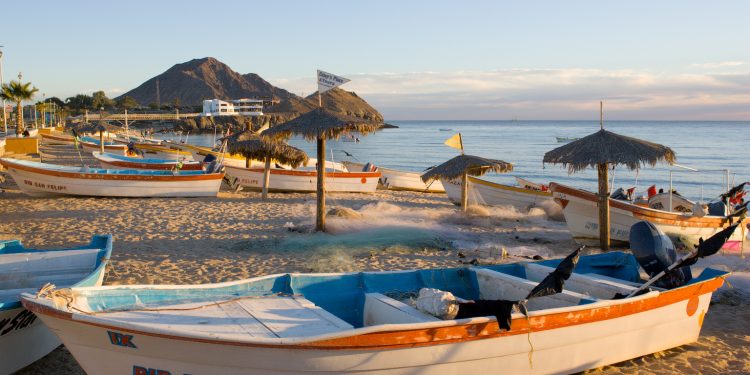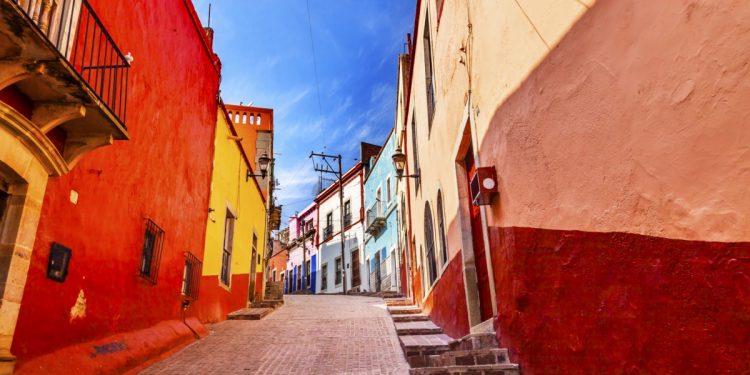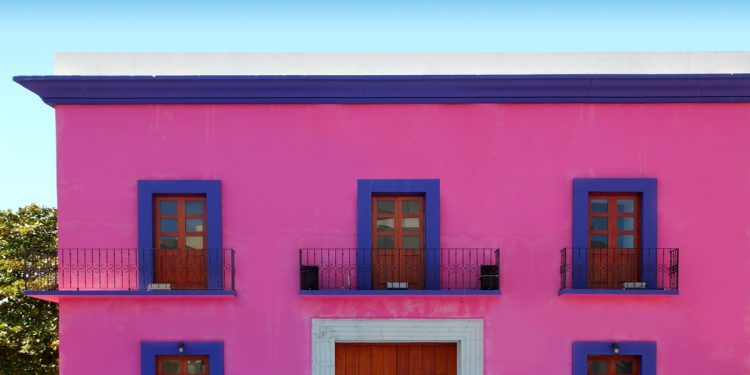Research and assess San Felipe as a location for living, working or retirement in Mexico.
Living in San Felipe
Not long ago, San Felipe was a sleepy fishing town. Today, it’s host to one of Mexico’s retirement communities.
San Felipe At-a-Glance:
Location Type
Population
15,000 (2005 Census). The local population can increase by up to 40% in the winter months.
Altitude
9 feet above sea-level
Time Zone
High/Low Temperatures
38F (Nocturnal, Winter), 95F (Daytime, Summer). Year-Round Average 78F.
Rainy Season?
San Felipe does not experience a monsoon rains season; most rainfall takes place in late August and September
Hurricanes?
San Felipe is sometimes subject to adverse weather arising from Pacific hurricanes.
Local Economy:
Principally fishing (Shrimp Fishing) and tourism.
Expat Penetration
Moderate*
Cost of Living*
Moderate (About Average)
Travel Guide
Safe in San Felipe
*Relative to other foreign expat communities in Mexico
San Felipe is situated on Mexico’s Baja peninsula, about a two-hour road drive (125 miles) south of Mexicali on the U.S.-Mexico Border. The town’s proximity to the U.S.A. is one of the prime features which attracts foreigners, and particularly Americans, to consider the town as a place for part-time or full-time living and retirement.
The Baja Peninsula is divided into two states: Baja California, and Baja California Sur, and is a socially and politically unique region of Mexico. There exists a considerable amount of U.S. influence here and the peninsula is becoming autonomous in many ways to the rest of Mexico, albeit the land and the local people who inhabit it continue to exude Mexican culture and values.
“The Baja” as the peninsula is often referred to, is tightly linked to the United States in many ways; in part because of the geography and in part due to the massive U.S. investment — both corporate and individual — that is taking place here. For example, many prices in Los Cabos are routinely quoted in U.S. Dollars; and, at a macro level, Baja California produces its own electricity — so much, that it exports the excess for sale to California in the U.S.A.
Mexican authorities also recognize the uniqueness of this land space and have made special allowances, such as allowing U.S.-plated motor vehicles to enter and remain on the peninsula, provided that the vehicle’s U.S. tax stickers are kept current. Elsewhere in Mexico, vehicles require an import permit and must be legalized (plates changed to Mexican plates) or exported (driven back across the border) within a fixed time period.
The peninsula’s geography, the ties to the United States, and the unabating investment pouring-in from Mexico’s northern neighbor as well from Mexican interests, provide retirees and people who want to live (and possibly work) in Mexico a very unique opportunity: to live in a region that is undoubtedly Mexican, but which has many of the hues and benefits of being so closely associated with the U.S.A.
Of course, the influx of investment and interest over the last fifteen to twenty years means that land and property prices have risen considerably over the period; however, since the credit crisis that began in late 2007, prices have begun to atone and relative bargains may now be sought in the region.
With over 55,000 square miles of land space, the Baja peninsula is huge. Baja California is over 27,000 square miles in size; its capital city is Mexicali. Baja California Sur, that incorporates Los Cabos, is a little over 28,000 square miles in size. The southern state on the peninsula is the least densely populated state in Mexico, with just one person for every four square miles of land space. Its capital city is La Paz.
The Baja peninsula offers a diverse range of options for people who want to live retire and even work in Mexico. For example, Los Cabos offers top-level amenities and local services; however, if you want to live more simply, there are alternative spaces, like those in and around San Felipe, offering land parcels ideal for the construction of eco-homes in Mexico.
The peninsula offers good transport links by road, air and ferry. People who own their own boats also find the many ports and marinas make the peninsula easily accessible.
The climate in this region is divine; it’s one of the biggest attractions for retirees and even then, there is choice. Although the coastal areas get hot and sultry in the summer, sea breezes cool them down; for those who need respite from the heat, mountain ranges that climb over a mile high above sea-level offer altitude and cooler temperatures.
With the advent of developments in San Felipe and some other notable towns in the northern reaches of the peninsula including Rosarito Beach, Ensenada and San Quintin, the north of the peninsula has taken on a new life: the inward investment is bringing new, modern, infrastructure, amenities and services to areas which, like the southern area of the peninsula, were once sleepy villages and this investment is opening up opportunities for foreigners who are looking for comfortable, affordable and well-connected locations to retire to in Mexico.
San Felipe has moved beyond the “fishing village” status it once had and is now regularly frequented by foreign visitors as well as expats who make this place their home part-time or full-time. Choosing San Felipe as a place to live or retire means that you will arrive with a number of retirement communities already established, infrastructure, amenities and services already in place, and the location still offering plenty of space for future growth: both in terms of community development and longer term investment.
Affordable Living
Affordability is another factor. The Baja peninsula is organized into two Mexican states: Baja California and Baja California Sur. The southern reaches of the peninsula, and particularly Los Cabos (‘the capes’, comprising of San Jose del Cabo and Cabo San Lucas) have experienced a two-decade long boom, attracting an influx of foreign investors and retirees. This has driven up prices in the south, whereas in the north (Baja California), development has been hitherto subdued in comparison; the penetration of expats has been lower and so market prices match that lower demand.
Eco Homes
San Felipe is also emerging as one of the world’s premier locations for people who want to buy land and develop an Eco (or Energy Efficient) Home in Mexico. Technologies that enable home owners to be self-contained in terms of heat, light, water and sewerage have experienced a massive leap in recent years. San Felipe offers parcels of land which are extremely affordable and ideally situated for the construction of an Eco Home. You can get detailed information about Eco Homes in Mexico on Mexperience.
Seaside and Desert Living
Waterside lands with permission to build residential dwelling houses and homes overlooking the sea have become almost unaffordable for most people in places like the U.S.A., Canada and Western Europe.
People who harbor dreams of living near or alongside the sea find that San Felipe is still affordable and, if where plans exist to create an Eco Home, lands set aside for that purpose can be secured for less than U.S.$20,000 per plot.
The region’s desert climate, with winter temperatures (Dec-Mar) averaging in the mid 60’s F, spring temperatures (Apr-Jun) rising to averages in the late 70’s F, and summer temperatures (July-Sep) reaching as high as the mid 90’s F, San Felipe offers an attractive year-long climate for living and retirement.
Cost of Living in San Felipe
The cost of living in Mexico is typically lower in Mexico than it is the USA, Canada and Western Europe, although precise costs depend upon where you live and your lifestyle choices.
Cost of Living Report
To learn more about the cost of living in Mexico, connect to the Mexico Cost of Living page on Mexperience.
Regional and geographical cost variations do exist, and this part of the guide shows you how some goods and services at San Felipe vary from the average.
See Also:
Banks, Banking and Credit in Mexico | Money in Mexico
Blog Articles:
Real Estate in San Felipe
The real estate market, like many others across Mexico, surged between the late 1990’s and 2007. Recent market conditions have caused price rises to stall, which is now creating an investment opportunity for people who want to make a long term commitment to the area.
Price rises, although significant, did not climb so high as to make San Felipe unaffordable, and the low cost of land reserved for the construction of eco-homes, proffers a unique opportunity for people seeking to create an energy efficient “off the grid” home in Mexico.
Real Estate Market in San Felipe
With FONATUR’s multi-million dollar investment combined with the close location to the U.S.A., San Felipe has emerged from its status as a sleepy fishing village to a thriving community whose main economy is now tourism, retirement communities, and real estate.
During the early 2000’s a real estate boom occurred and now a number of developments can be found along the coast beginning in the north end of town, through the town of San Felipe proper, and extending south of town.
Most real estate is sold directly through the developers although there are a couple of real estate agencies in town marketing individual properties. Real estate types range from beachfront homes, lots, and condos. Residences are available in the town of San Felipe as well as out-of-town, where investors are buying desert homes offering tranquil surroundings and sea and mountain views. While prices have escalated there has been a modest price correction recently.
San Felipe is also a location for people who want to build and live in Eco and Energy Efficient Homes in Mexico; plots of land which are ‘off the grid’ may be acquired at very low prices.
Rentals Market in San Felipe
Most rental properties in San Felipe are offered through developers or by individual property owners listing properties on the Internet. Although there are a few expatriates marketing rental services there does not exist a reliable rental agency at this time.
See Also:
Guide to Real Estate in Mexico | Home Maintenance | Home Security
Health and Healthcare in San Felipe
Good quality basic healthcare services, as well as a small clinic offering U.S.-standard healthcare services exists in San Felipe. In addition to Mexico’s state sponsored healthcare provided via the country’s national health service IMSS, good quality healthcare services offered through private clinics with US -standard healthcare services exist in San Felipe and in nearby Mexicali and a little further away in Tijuana. The privately-run out patient clinics available locally are ideal for day-to-day ailments, sprains, broken bones and other health matters which would normally be diagnosed and treated by a General Practitioner of medicine.
See Also:
Health and Healthcare in Mexico | Travel Health in Mexico
Local Climate in San Felipe
San Felipe enjoys a yearly average temperature of 78F/24C. Winter months can be cooler and drop to 38F/4C at night; summer months may reach highs of 95F/32C.
Winter Climate:
November through February are the coolest months. Temperatures can range from 38F/4C to 70F/19C in the day.
Spring Climate:
March through May – springtime – are warm months in San Felipe with temperatures ranging from 50F/10C overnight to 80F/25C in the daytime.
Summer Climate:
June through August are the hottest months, with temperature ranging from 60F/15C overnight, to 95F/32C in the daytime. Temperatures reach their peak in mid-July and August; this is a time when many local residents leave the area to go traveling and retirees leave to visit families back home; returning in mid September as the climates further north begin to turn cool or cold, and temperatures in San Felipe begin to moderate.
Autumn Climate:
Temperatures moderate again starting in mid September through November, returning to similar levels as those experienced in the springtime ranging from 50F/10C overnight to 80F/25C in the daytime.
Rainy Season:
San Felipe does not experience a “rainy season”, although it does get a good deal of rainfall in late August and September, when hurricanes from the Pacific can cause adverse weather conditions across the Baja peninsula.
Hurricanes:
As San Felipe is on the Sea of Cortez, it is rarely directly affected by hurricanes, which brew in the Pacific, and lose strength as they cross land. However, hurricanes can affect the general weather here, causing heavy rain, overcast skies and winds.
Sea Temperature in San Felipe
During the peak summer months of July and August, sea temperatures reach as high as 80F/23C; in other months, the sea temperature will average around 50F/9C.
See Also:
Weather and Climates in Mexico
Practical Information About Living in San Felipe
This section contains links to guides where you can learn more about living in San Felipe.
Accessibility / Transport
Getting Around
Transportation choices in Mexico
Communications
Staying in contact while living in Mexico
Money and Banking
Guide to Money in Mexico | Banks & Banking in Mexico
Practical Matters
Practical Information (Travel Guide)
Auto Insurance in Mexico
How to insure your foreign-plated car in Mexico
Safety in Mexico
Key Attractions
Mexico in your inbox
Our free newsletter about Mexico brings you a monthly round-up of recently published stories and opportunities, as well as gems from our archives.





